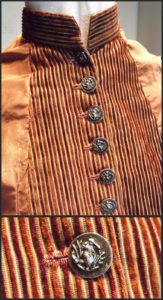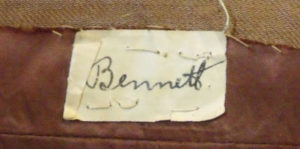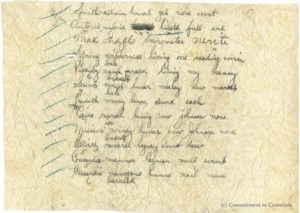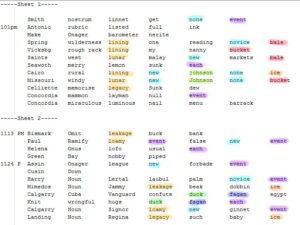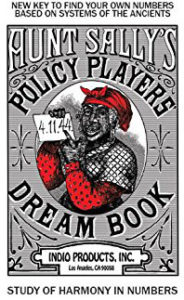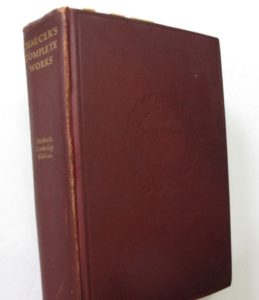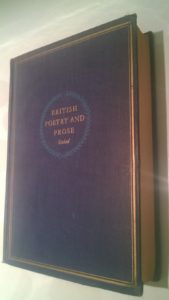As I wrote before, I think we have four foundational challenges to tackle before we can get ourselves into a position where we can understand Voynichese properly, regardless of what Voynichese actually is:
* Task #1: Transcribing Voynichese into a reliable raw transcription e.g. EVA qokeedy
* Task #2: Parsing the raw transcription to determine the fundamental units (its tokens) e.g. [qo][k][ee][dy]
* Task #3: Clustering the pages / folios into groups that behave differently e.g. Currier A vs Currier B
* Task #4: Normalizing the clusters i.e. understanding how to map text in one cluster onto text in another cluster
This post relates to Task #2, parsing Voynichese.
Parsing Voynichese
Many recent Voynichese researchers seem to have forgotten (or, rather, perhaps never even knew) that the point of the EVA transcription alphabet wasn’t to define the actual / only / perfect alphabet for Voynichese. Rather, it was designed to break the deadlock that had occurred: circa 1995, just about every Voynich researcher had a different idea about how Voynichese should be parsed.
Twenty years on, and we still haven’t got any consensus (let alone proof) about even a single one of the many parsing issues:
* Is EVA qo two characters or one?
* Is EVA ee two characters or one?
* Is EVA ii two characters or one?
* Is EVA iin three characters or two or one?
* Is EVA aiin four characters or three or two or one?
…and so forth.
And so the big point of EVA was to try to provide a parse-neutral stroke transcription that everyone could work on and agree on even if they happened to disagree about just everything else. (Which, as it happens, they tend to do.)
The Wrong Kind Of Success
What happened next was that as far as meeting the challenge of getting people to talk a common ‘research language’ together, EVA succeeded wildly. It even became the de facto standard when writing up papers on the subject: few technical Voynich Manuscript articles have been published since that don’t mention (for example) “daiin daiin” or “qotedy qotedy”.
However, the long-hoped-for debate about trying to settle the numerous parsing-related questions simply never happened, leaving Voynichese even more talked about than before but just as unresolved as ever. And so I think it is fair to say that EVA achieved quite the wrong kind of success.
By which I mean: the right kind of success would be where we could say anything definitive (however small) about the way that Voynichese works. And just about the smallest proof would be something tangible about what groups of letters constitute a functional token.
For example, it would be easy to assert that EVA ‘qo’ acts as a functional token, and that all the instances of (for example) ‘qa’ are very likely copying mistakes or transcription mistakes. (Admittedly, a good few o/a instances are ambiguous to the point that you just can’t reasonably decide based on the scans we have). To my eyes, this qo-is-a-token proposition seems extremely likely. But nobody has ever proved it: in fact, it almost seems that nobody has got round to trying to prove anything that ‘simple’ (or, rather, ‘simple-sounding’).
Proof And Puddings
What almost nobody seems to want to say is that it is extremely difficult to construct a really sound statistical argument for even something as basic as this. The old saying goes that “the proof of the pudding is in the eating” (though the word ‘proof’ here is actually a linguistic fossil, meaning ‘test’): but in statistics, the normal case is that most attempts at proof quickly make a right pudding out of it.
As a reasonably-sized community of often-vocal researchers, it is surely a sad admission that we haven’t yet put together a proper statistical testing framework for questions about parsing. Perhaps what we all need to do with Voynichese is to construct a template for statistical tests for testing basic – and when I say ‘basic’ I really do mean unbelievably basic – propositions. What would this look like?
For example: for the qo-is-a-token proposition, the null hypothesis could be that q and o are weakly dependent (and hence the differences are deliberate and not due to copying errors), while the alternative hypothesis could be that q and o are strongly dependent (and hence the differences are instead due to copying errors): but what is the p-value in this case? Incidentally:
* For A pages, the counts are: (qo 1063) (qk 14) (qe 7) (q 5) (qch 1) (qp 1) (qckh 1), i.e. 29/1092 = 2.66% non-qo cases.
* For B pages, the counts are: (qo 4049) (qe 55) (qckh 8) (qcth 8) (q 8) (qa 6) (qch 3) (qk 3) (qt 2) (qcph 2) (ql 1) (qp 1) (qf 1), i.e. 98/4147 = 2.36% non-qo cases.
But in order to calculate the p-value here, we would need to be able to estimate the Voynich Manuscript’s copying error rate…
Voynichese Copying Error Rate
In the past, I’ve estimated Voynichese error rates (whether in the original copying or in the transcription to EVA) at between 1% and 2% (i.e. a mistake every 50-100 glyphs). This was based on a number of different metrics, such as the qo-to-q[^o] ratio, the ain-to-oin ratio, the aiin-to-oiin ratio, the air-to-oir ratio, e.g.:
A pages:
* (aiin 1238) (oiin 110) i.e. 8.2% (I suspect that Takeshi Takahashi may have systematically over-reported these, but that’s a matter for another blog post).
* (ain 241) (oin 5) i.e. 2.0% error rate if o is incorrect there
* (air 114) (oir 3) i.e. 2.6% error rate
B pages:
* (aiin 2304) (oiin 69) i.e. 2.9% error rate
* (ain 1403) (oin 18) i.e. 1.2% error rate
* (air 376) (oir 6) i.e. 1.6% error rate
It’s a fact of life that ciphertexts get miscopied (even printed ciphers suffer from this, as Tony Gaffney has reported in the past), so it seems unlikely that the Voynich Manuscript’s text would have a copying error rate as low as 0.1% (i.e. a mistake every 1000 glyphs). At the same time, an error rate as high as 5% (i.e. every 20 glyphs) would arguably seem too high. But if the answer is somewhere in the middle, where is it? And is it different for Hand 1 and Hand 2 etc?
More generally, is there any better way for us to estimate Voynichese’s error rate? Why isn’t this something that researchers are actively debating? How can we make progress with this?
(Structure + Errors) or (Natural Variation)?
This is arguably the core of a big debate that nobody is (yet) having. Is it the case that (a) Voynichese is actually strongly structured but most of the deviations we see are copying and/or transcription errors, or that (b) Voynichese is weakly structured, with the bulk of the deviations arising from other, more natural and “language-like” processes? I think this cuts far deeper to the real issue than the typical is-it-a-language-or-a-cipher superficial bun-fight that normally passes for debate.
Incidentally, a big problem with entropy studies (and indeed with statistical studies in general) is that they tend to over-report the exceptions to the rule: for something like qo, it is easy to look at the instances of qa and conclude that these are ‘obviously’ strongly-meaningful alternatives to the linguistically-conventional qo. But from the strongly-structured point of view, they look well-nigh indistinguishable from copying errors. How can we test these two ideas?
Perhaps we might consider a statistical study that uses this kind of p-value analysis to assess the likeliest level of copying error? Or alternatively, we might consider whether linguistic hypotheses necessarily imply a lower practical bound for the error rate (and whether we can calculate this lower bound). Something to think about, anyway.
All in all, EVA has been a huge support for us all, but I do suspect that more recently it may have closed some people’s eyes to the difficulties both with the process of transcription and with the nature of a document that (there is very strong evidence indeed) was itself copied. Alfred Korzybski famously wrote, “A map is not the territory it represents”: similarly, we must not let possession of a transcription give us false confidence that we fully understand the processes by which the original shapes ended up on the page.


